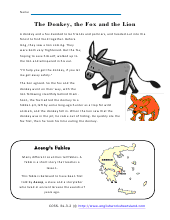Determining the Moral of Fables and Folklore Worksheets
Related ELA Standard: RL.3.2

Fables are short fictitious tales that usually convey a sense of behavior that is acceptable. The central theme of these stories is to help the reader understand the difference between good or bad human traits and acts. Folklore often is told in tales that have been passed down from generation to generation within many different cultures. Just like fables, folklores main intention is to examine human behavior. These worksheets will help students examine different well known tales and help them identify where they are going.
Determining the Moral Worksheets:
That Darn Cat! –
A house full of mice and a kitty, sounds like trouble!
The Jaguar – You may
not have ever heard of this one.
Aesop's Fables
– A mouse bites the nose of a bull and then it's off to the races.
The Old
Lion – It's a sad day when a lion is no longer able to hunt.
The Wolf
and the Crane – Wolves always have trouble with bones. I never
knew how common this truly is until we visited a Western zoo.
Pandora's
Box – Don't open it! I'm not sure many people could resist the
temptation.
The Old
Man – A thief plots to spoil an old man's birthday.
How Do You Determine the Moral Of the Fables and Folktales?
Folktales:
Folktales are the traditional stories having humans as the character in it. They are little longer stories having twists in them. They are delivered orally from generation to generation.
Fables:
Fables are the short stories that teach a moral. These stories contain animals and non-living objects as main characters around which the story evolves. The characters (animals or things) act in such a way that they show the characteristics of human such as the ability to talk or make decisions.
At the end of these folktales and fables, the good get rewarded and the evil ones get punished and justice is granted to everyone.
Moral of the Story:
A moral is a lesson that an author wants you to learn from the story you read. Every fable has a message or moral which is the reason for writing that story.
Determining Moral of the Story:
After reading a story, you need to decode it first when you are looking for the moral in it. You may find it by observing:
- Who the characters are?
- What do the characters think, say and do?
- What happens to the characters and how do they react?
- What do the characters face at the end of the story?
Example:
If we take the example of the fable "the tortoise and the hare", in this story, the hare was fast and always bragged about his speed, so the tortoise challenged him. They started the race and during it the hare became overconfident about his speed and stopped to rest and mistakenly fell asleep while the tortoise kept on running with his slow speed and won the race.
The end of this story teaches that we shouldn't brag about our qualities and become overconfident. Doing things slowly doesn't fail someone, but carelessness does.

